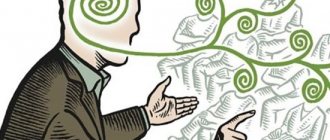There are many similarities and differences between people; each of us has our own unique set of traits and characteristics, and above all this concerns the mechanisms of our thinking. Of course, we are all different from each other, we are personalities, individuals, and in the whole world you cannot find a person who is one hundred percent identical to us. But you can still find something in common in our thinking.
Psychologists have been studying human mental activity for centuries, and have come to the conclusion that there are five basic styles of thinking. Today we will introduce you to them and tell you how to determine yours. We are sure that this information will be useful to you in your everyday and professional life, because knowing the features of how you think, you will be able to solve your tasks much more effectively, cope with problems and achieve goals.
What does synthetic thinking mean?
Two main mental operations - analysis and synthesis - are reflected in the types of human thinking. People with an analytical mindset examine phenomena in detail, and, having identified the main parts in each component, deduce the patterns of their connections. People with a synthetic mindset are able to see the phenomenon as a whole, and at the same time they can predict how events will develop.
Imagine that you are playing chess. The enemy makes a move, you defend. The opponent makes a second move, you defend again and suddenly discover that two pieces, including the queen, are under threat. You acted analytically because you assessed the current state of affairs in a specific situation. Your opponent has predicted your moves and made a plan of action in advance. It is synthetic.
Important! There are much fewer people in whom this type of thinking predominates than those who have a more developed ability to analyze. At the same time, a developed ability to analyze does not mean an inability to synthesize.
Most people can do both surgeries, but one is more time consuming and stressful.
Benefit
Psychologists and teachers recommend developing an analytical mindset from childhood, as it makes life easier and allows you to solve not only complex mathematical, but also pressing, topical problems:
- see the main and the secondary, focusing on the first;
- appreciate the advantages and not lose sight of the disadvantages;
- identify all available opportunities and understand where their limitations begin;
- analyze based on experience and new information;
- draw your own conclusions and conclusions;
- disagree with the majority opinion;
- make decisions independently;
- skillfully use search engines to identify the necessary information;
- detailed planning of your activities;
- set realistic goals.
In childhood, a penchant for analytical thinking helps a child stand out from other children with his non-standard approach to solving any problems. Mathematics, physics, chemistry, and history are usually easy for him. He studies well and has a high IQ. From a psychological point of view, he is absolutely non-conflict, because he sees all the disadvantages of quarrels and tries to resolve them diplomatically.
With age, such people choose from thousands of professions the one that will help them reach their maximum potential. They do not have problems with admission, because they first study statistics on different educational institutions and meticulously calculate which of them have a chance of getting into.
Accordingly, they are successful in their professional activities and only move up the career ladder, because they know how to set realistic goals and consistently achieve them.
Main features
You can recognize synthetics by the following features:
- Developed intuition . Synthetics often cannot explain why they are confident in a particular development of events, but their premonitions very rarely deceive them.
- Losing details from sight, inattention to them . It is difficult for synthetics to go from the particular to the general; specifics interest them only if it helps to better understand some features of the general.
- The ability to “grab” information “on the fly”, quickly understand the essence . Synthetics subtly sense the interlocutor, often giving the impression of people who seem to read minds.
- The ability to see patterns within a whole . An analytical doctor treats a specific disease and relieves its symptoms, while a synthetic doctor tries to understand the cause of the disease and its effect on the functioning of other organs.
- Predominance of the right hemisphere, responsible for intuitive, imaginative, visual perception . You can check which hemisphere is dominant in you using a simple test, which is described in the video below.
Processing the results
You can determine your preference for one style or another using the key. In order to obtain data for each style, it is necessary, using the key, to sum up the points from the answer form. Before proceeding to their analysis, you need to check the correctness of the calculations. To do this, you need to add up the total indicators for all five styles. The resulting number should be equal to 270. Otherwise, the calculations must be double-checked.
Key
- Synthetic style
: 1a, 2b, 3d, 4d, 5c, 6b, 7a,8b, 9d, 10d, 11c, 12b, 13a, 14b, 15d, 16d, 17c, 18b. - Idealistic style
: 1b, 2a, 3d, 4c, 5a, 6c, 7b, 8a, 9d, 10c, 11a, 12c, 13b, 14a, 15d, 16c, 17a, 18c. - Pragmatic style
: 1c, 2d, 3a, 4d, 5b, 6d, 7c, 8d, 9a, 10d, 11b, 12d, 13c, 14d, 15a, 16d, 17b, 18d. - Analytical style
: 1d, 2c, 3c, 4a, 5d, 6d, 7d, 8c, 9c, 10a, 11d, 12d, 13d, 14c, 15c, 16a, 17d, 18d. - Realistic style
: 1d, 2d, 3b, 4b, 5d, 6a, 7d, 8d, 9b, 10b, 11d, 12a, 13d, 14d, 15b, 16b, 17d, 18a.
Physicists and lyricists
People are often divided into humanists and those who prefer technical specialties. It is believed that humanists think in images, they have a well-developed imagination, while physicists, mathematicians and programmers have purely logical and practical thinking. This point of view is very common, but extremely erroneous.
In fact, the humanitarian and mathematical mindset does not exist. Both mathematics and programming are abstract sciences that operate with intangible (invisible to the eye) units: numbers, lines, curves and symbols. To derive formulas and describe physical phenomena, imaginative thinking is necessary in the same way as to analyze a work of art and study a language.
Russian linguist V.K. Zhuravlev believed that the methods of mathematics, the “queen of sciences,” should be actively used in linguistics, because only with such an approach is the qualitative development of linguistics possible.
Attention! Any scientific thinking, regardless of the field of science chosen, is more or less abstract, that is, it is based on synthesis. Humanities scholars have this ability no less than physicists.
Psychologists sometimes say that the human psyche is divided into feeling and thinking types. With this approach, the analytical and synthetic types belong to the thinking type, and the feeling type is placed in a separate category.
Poets, musicians, artists perceive the world with the help of feelings and their unconscious. They evaluate and record images born in the brain, which can be expressed in sound (music), color (painting) or words (poetry).
The synthetic mentality is not equal to the sentient one. Synthetics not only sense the world, but also derive logical laws and rules in it, compare, compare. They seek meaning and purpose in cognizable phenomena.
A practical guide to thinking styles.
A thinking style is a system that has a relatively constant core, structure, and selectivity to external influences. Each of us thinks within the framework of the style that has developed in the course of life, often believing that this style is optimal. Let's look at the five main thinking styles and their combinations.
When making a decision, we voluntarily or unwittingly use a set of certain mental strategies. Each set of strategies has its own strengths and weaknesses. Each can be useful in some specific situation, but can also lead to disaster if used excessively or incorrectly.
Despite this, each of us masters only one or two sets of strategies and applies them throughout our lives, regardless of the nature of the situation. We rarely take the trouble to find new ways of thinking, although by doing so we could increase our adaptability to problematic situations and events in everyday life.
It doesn't matter at all how much people like each other, how well they get along, or how nice they seem. When it comes to solving a problem or making a decision, any two people chosen at random will likely not only approach the situation differently - it will appear as if they are dealing with two different situations.
The original concept of a typology of the effectiveness of using an individual’s intellectual resources was proposed by A. Harison and R. Bramson and adapted for the Russian audience by A. Alekseev and L. Gromova (1993). Knowledge about thinking styles should help managers:
- learn to find a common language with “difficult” people and influence them more effectively;
- develop the strengths and weaknesses of the intellect, make it more powerful and effective;
- become more accurate and objective in perceiving, understanding and evaluating what other people say and do.
The concept of “thinking style” (or “intellectual style”) reflects a trivial fact: all people think differently about the same thing. Individual differences in thinking turned out to be so diverse, depending on such a large number of factors, that it has not yet been possible to bring them to a common denominator, despite the almost century-long history of their experimental study.
Thinking style is understood as an open system of intellectual strategies, techniques, skills and operations to which a person is predisposed due to his individual characteristics. Thinking styles begin to develop in childhood and develop throughout a person's life.
However, the style of thinking is, although open, that is, replenished all the time, but a system that has a relatively constant core, structure and selectivity to external influences. There are also people with a complex stylistic organization who have more than one such core. They either have an equally good command of several styles of thinking (more precisely, a combination of them), or are characterized by what can be called intellectual spinelessness (not to be confused with low intelligence!). Let's look at the five main thinking styles and their combinations.
The most important distinguishing feature of the qualitative approach is the recognition of the equivalence of all styles of thinking. Each of them has strengths and weaknesses, but by themselves they cannot be ranked from “best” to “worst” (or from “smart” to “stupid”). Thinking styles do not depend on the level of intelligence development.
Each of us thinks within the framework of the style that has developed in the course of life, often believing that this style is optimal. Some of us cannot even imagine that it is possible to think differently, frame questions differently, make decisions differently, etc.
Characteristics of Thinking Styles
1.1. Synthetic style
The main strategy of synthesis is dialectics. Essentially, to synthesize means to create something qualitatively new and original from things or ideas that themselves do not possess similar qualities and look sharply different from each other, and sometimes completely incompatible.
Combining dissimilar, often opposing ideas, views, positions, etc. is exactly what Synthesizers enjoy doing most. Their favorite form of thinking is speculative (that is, theorizing) thinking, a thought experiment. The Synthesizer's motto is “What if?..”
Synthesizers are always integrators. They are looking for a way to “combine the incompatible” in a new combination. Unlike owners of other styles of thinking, they themselves firmly recognize only one “fact”: differences of opinion on facts have always existed, exist and will exist among people.
Those with a synthetic style are extremely sensitive to contradictions in the reasoning of others and have an increased interest in paradoxes and conflicts of ideas. Moreover, they are often interested in the emergence of such conflicts and can even provoke them by asking unexpected, sharp “Socratic” questions in order to clarify the starting positions of the other side.
Finally, another passion of Synthesizers is the love of change. They tend to see the world as constantly changing and approve of other people's vision of the world. Synthesizers are not afraid of uncertainty, but untrodden paths and the unknown irresistibly attract them to themselves: what if something new appears around the next turn? They probably thereby often complicate their own lives, but Synthesizers are proud of their creativity (that is, the ability and inclination to create in the broad sense of the word), their sense of the new, their sharpness of sight and language, and, often secretly, their talent (alas, not always recognized others).
1.2. Idealistic style
The main strategy of the idealist is associative thinking. Idealists are people who, first of all, have a broad view of things. They are prone to intuitive, global assessments and do not bother themselves with a detailed analysis of problems based on a full set of facts and formal logic.
Another feature of Idealists is an increased interest in goals, needs, motives and, naturally, human values. They are good at formulating goals, and not only their own. “Where are we going and why?” - a classic question from Idealists. They are especially interested in the “quality of life”: what is good and what is evil in this world.
Idealists are similar to Synthesizers in that they are not inclined to concentrate on hard numbers and dry facts. The difference between them lies in different approaches to resolving contradictions. Idealists tend to believe that differences and disputes can always be resolved. We are convinced that people are able to agree on anything as soon as they agree on goals. From this it is clear that Idealists do not value conflict and do not enjoy it; conflict seems to them unproductive and therefore completely unnecessary.
The thinking of Idealists can be called receptive, i.e. easily and without internal resistance perceiving a wide variety of ideas, positions and proposals.
Idealists like to be perceived as open, trustworthy, supportive, and helpful to others—that is, helpful to people. Satisfying their needs requires high quality work and exemplary behavior. Because of their “too” idealistic standards, they are often disappointed in people whose aspirations and standards seem to them less exalted than their own.
When it comes to finding a solution to a problem, Idealists demonstrate high professionalism in situations where it is difficult to clearly formulate the problem and where emotions, feelings, assessments and values are important factors.
1.3. Pragmatic style
The main strategy of a pragmatist is to take into account possibilities in every possible way. The motto of the Pragmatists is: “Anything that works” is good. Direct personal experience is their main and only measure of the correctness/incorrectness of ideas, decisions, actions, and life in general.
Pragmatists stand out among other people by their tendency to find new ways to satisfy their own and others' needs using only those materials and information that are at hand. It is not common for them to request additional funds, resources, much less reserves. In solving any problems, they tend to demonstrate a gradual, “piecemeal” or incremental approach - “one thing at a time” and “from now to now” with the goal of getting a specific result as quickly as possible. Pragmatists are more similar to Realists than to representatives of other thinking styles.
More on the blog: Why poverty is convenient
While the Analyst believes in predictability and the Idealist in “noble intentions,” the true Pragmatist does not believe in such “nonsense.” In his opinion, the world as a whole is unpredictable, practically impossible to understand, much less manage. Therefore, “we’ll do this today, and then we’ll see.”
As a rule, the behavior of Pragmatists is less predictable than the behavior of owners of other styles of thinking, primarily because it is extremely difficult to guess the course of their thoughts due to the arbitrariness in the choice of facts.
Pragmatists have a good sense of the situation and have the ability to grasp supply and demand in the broadest sense of these words. And they are happy to share their thoughts with others, always ready to collaborate, enthusiastically involved in the process of collective thinking and decision-making, showing a sincere interest in formulating strategies and tactics for quickly achieving goals.
In general, Pragmatists are quite flexible and adaptive people, both in terms of thinking and behavior. They usually have well-developed communication skills; are able to put themselves in the shoes of another person. They are far from indifferent to the attitude of others towards them; they want to be liked, approved, or at least accepted for their thoughts and behavior.
1.4. Analytical style
The main strategy of the Analyst is to find the best path. Representatives of the analytical style are distinguished by a logical, methodical, thorough (with an emphasis on detail) and careful manner of solving problems. Before making a decision, they develop a detailed plan and try to collect as much information as possible, so they often win.
Analysts are more theory-oriented than anyone else, but when they are told this, they are often surprised, disagree, and sometimes offended. Committed Analysts, especially those not directly involved in theoretical work, see themselves as realistic, fact-based, practical people. Of course, in a certain respect they are. However, behind the attention they pay to objective facts lie broad and deep theories.
In general, Analysts tolerate the unknown, uncertainty, and chaos worse than others. They tend to see the world as logical, rational, orderly and predictable.
Analysts value knowledge, take learning seriously, and from an early age acquire a variety of theories that help them explain events and bring order to their environment. In addition, they respect authorities, do not like to change their views and preferences, and try to regularly apply the acquired theoretical knowledge in practice. Over time, the process of applying the learned “theories” becomes automatic and ceases to be recognized by them.
When a problem arises, the Analyst will most likely look for a formula, procedure, method, or system that can provide a solution to the problem. Because of his dominant interest in method, he strives to find the “best way” to solve a problem.
While the Synthesizer has an interest in conflict, change and novelty, the Analyst prefers rationality, stability and predictability. Where the Idealist focuses on values, goals, and the “big picture,” the Analyst prefers to focus on objective data, procedure, and “best method.” While the Pragmatist's approach is experimental, the Analyst's approach is based on a detailed, detailed plan and a search for a rationally justifiable "best way."
Analysts spend a lot of effort obtaining information. They pride themselves on their competence, knowledge and understanding of all sides of any situation.
1.5. Realistic style
The main strategy of the Realist is empiricism. In most respects, Realists are at the opposite end of the thinking style spectrum from the Synthesizer.
Many people have difficulty understanding the differences between Realists and Pragmatists. In fact, in everyday speech these two terms are often used as synonyms, but this is not the case. Pragmatists and Realists rely on different underlying assumptions and values, and the mental strategies they use are fundamentally different, although often complementary.
The Realists' motto is: "Facts are facts." In other words, Realists are primarily empiricists, not theorists. For them, “real” is only what can be directly felt: felt, touched, personally seen or heard, experienced, etc. This is where they are the opposite of Synthesizers, who are convinced that interpretation and conclusions are always more important observable "facts". Realists cannot help but see that people do not always agree with each other. Because they believe that without reaching agreement at the level of facts, things cannot be done and there is no point in starting anything at all.
“Realistic thinking” is characterized by specificity and an attitude towards correction, correction of the situation in order to achieve a certain result. The problem for Realists arises whenever they see something is right and want to fix it. Unlike Pragmatists with their penchant for experimentation (“it didn’t work out this way, let’s try that”), realists want to conduct business accurately, reasonably and with full confidence that if they have already corrected something, then it will continue to be done without surprises and unforeseen changes. And if something does happen, they will try to introduce another amendment and again firmly stick to the chosen course.
In general, Realists are much closer to Analysts than to everyone else. Both of them are based on facts, are focused on the objective, concrete and material, and show a tendency to be methodical and practical results. But there are also fundamental differences between them. The Realist will probably be irritated by the deductive, formal-logical procedures of the Analyst, as well as the latter’s desire to collect additional information and search for perfection. A realist wants to do a specific task as well as possible, based on the facts at his disposal.
What Realists and Synthesizers have in common is the need to be in control. Realists feel the need to control resources, people and results, Synthesizers - the need to control the process: understand and stay one step ahead of a certain decision, conflict or simply argumentation; both tend to become irritated by overly detailed analysis and protracted discussion. Finally, they are proud of their harshness, causticity, and ability to confuse others.
Diagnostics of thinking styles
2.1. How to recognize a Synthesizer
Synthesizers often behave defiantly, openly express skepticism, mock, and precisely when you find no reason for such behavior. They tend to be in opposition, especially to popular opinion, to disagree with what everyone seems to agree with without hesitation.
Synthesizers place themselves, as it were, above the situation, breaking away, in the opinion of others, from reality. Naturally, such behavior causes irritation in many and a desire to bring them back to earth, put them in their place, besiege them. But true Synthesizers are original and that alone deserves respect. They are the ones who find an aspect or approach to a problem that simply does not occur to others. Therefore, along with the irritation of some, Synthesizers evoke admiration (and secret envy!) of others.
Synthesizers love to point out to people the absurdity of the situation in which they find themselves. And this often turns out to be a turning point in the course of events.
In general, Synthesizers enjoy theorizing, philosophizing, formulating and resolving paradoxes only until the discussion becomes too serious or even dark and they realize, in addition to the absurdity of the behavior of others, the absurdity of the very act of arguing. Apparently, this is why many people think that Synthesizers do not take everything as seriously as others would like.
The synthesizer does not like to say what seems simplistic; he often tries to seem irrelevant to the issue being discussed. However, if you listen carefully to the Synthesizer, these digressions often turn out to be relevant and productive, although one may have to use all his intellectual resources to understand this.
More on the blog: Tunnel thinking or one step ahead
The Synthesizer’s speech is impressive, but quite complex: introductory words and sentences, qualifying adjectives and constructions (“probably”, “more or less”, “relatively”, “mainly”, “essentially”, “not at all”, “on the other hand” sides”, etc.)
In general, Synthesizers, like everyone else, may or may not be deep thinkers, but they are the ones most likely to give this impression of themselves.
There is one almost sure-fire way to recognize a Synthesizer. When you hear someone express a well-reasoned, fairly original and deep idea, and then suddenly smash it to smithereens and even make fun of themselves, you know: this is a Synthesizer.
2.2. How to recognize an Idealist
First of all, by an open, supportive and inviting smile, as well as by other, verbal and non-verbal, signals that Idealists send to partners in order to establish emotional contact and trusting relationships with them. They have a rich arsenal of means to achieve this goal. The input includes frequent nods of approval, an attentive and interested look, a confidential tone, indirect questions, soft, probing forms of expressing one’s views, etc.
The idealistic style of thinking is more common among people who are sociable or, more precisely, people who are inclined to communicate. More often than others, strangers talk to them in transport, public places, on the street, ask how to get to the right place, etc.
Sadness and resentment, disappointment and indignation are expressed just as openly in their facial expressions, pantomimes, gestures and speech as positive emotions. However, even in the depressed or indignant state of Idealists, there is something that makes people encourage and reassure them more often than others. Apparently, their appearance partly serves as a guarantee that a person who sympathizes with them will not run into hysteria and rudeness.
Idealists almost never behave boldly or defiantly. They feel very uncomfortable even in an open dispute, not to mention a conflict. In tense situations, all their behavior is subordinated to one goal - to prevent a quarrel from breaking out.
Idealists love to talk about people and their problems, discussed at the level of emotions, motives, and relationships. They do not like to overload their speech with facts and lose interest in others when they abuse the presentation and analysis of facts, especially if the latter are in no way related to personal problems.
Typically, Idealists ask a lot of questions to their communication partners, but this does not at all resemble an interrogation. A conversation with an Idealist inspires hope, because the Idealist needs questions to assess the other party’s need for his help or to clarify the partner’s life values, goals, intentions, in order to find common ground.
However, Idealists are extremely strong in their actions, beliefs, ethical and social standards.
2.3. How to recognize an Analyst
For many, the first meeting with the Analyst is puzzling, discouraging, confusing, or agitated, followed by irritation. The reason is the external dryness, restraint, coldness, formality and closedness of the Analysts. It is difficult to talk to them, especially for the first time, because by their appearance it is difficult to assess their intentions, attitude towards their partner, towards his words and actions. Sometimes it seems that they are not listening to you (this is not true, because they are listening, and very carefully). But when you get to know Analysts better and get used to their style of communication, you discover that it is very possible to deal with them.
Speech features are another reliable identifying feature of Analysts. In their normal state, they speak evenly, quietly, and restrainedly. The manner of speech is cautious, although quite firm and disciplined. Sometimes it even seems that these people are pronouncing pre-prepared phrases. Analysts are not those who like to spend time talking or tremble with impatience to make their opinions public. However, these are precisely the people who, if you turn to them for information, often tell you much more than you would like to know.
Analysts do not like to engage in conversations that seem irrational, illogical, aimless, “philosophical,” or “unconventional.” They also don’t like empty, “society” chatter, “excessive” frivolity, “inappropriate” jokes.
In tense situations, the Analyst appears stubborn and unshakable, at least at first. If the pressure on him does not stop, but on the contrary, increases, he simply leaves. This is a kind of psychological defense in difficult, emotionally charged situations.
The Analysts' humor is subtle, restrained, discreet and, again, rational. They are no strangers to irony.
Finally, another reliable sign of true Analysts is a thorough, serious, deliberate approach to everything they do.
2.4. How to recognize a Pragmatist
Like Idealists, Pragmatists often have an open, friendly appearance. However, in some respects they are more mobile, active, courageous, less impressionable and tense than Idealists.
Pragmatists enjoy easy communication. Humor, simple and clear ideas and proposals, interest and passion, speed and ease of agreement with partners - all this contributes to the development of communication and prevents tension. But sometimes it happens that Pragmatists “overact” and give the impression of insincere, hypocritical people. According to Pragmatists, more than one road leads to any goal, and no one knows in advance which will be the shortest.
What Pragmatists don't like is, firstly, abstract, theoretical conversations and speculative reasoning. Secondly, Pragmatists easily become bored when the conversation concerns details and becomes too formal (conducted strictly according to plan). In tense situations, when they are unable to defuse the situation and direct the course of events in the desired direction, Pragmatists usually look as if they are tired of everything and would rather it all end.
Pragmatists bring excitement to the most seemingly boring events, if only they are not disturbed: give space, do not control every step, maintain interest and enthusiasm. The opposite approach causes them irritation and boredom. And letting the Pragmatist get bored means losing him.
2.5. How to recognize a Realist
Realists look like ordinary people - open, direct, sincere, confident, strong and independent, assertive, and sometimes aggressive. To some, their directness and frankness may seem like a game, although, as a rule, this is not the case. They are really quick to express their opinions because, unlike many others, they have one. Probably for the same reason, they very quickly and clearly express their agreement or disagreement with their communication partner, using both verbal and nonverbal means.
Realists do not mince words, but they do not like sentimental or theoretical conversations. They themselves express themselves briefly and clearly and expect the same from others. They value their partner's frankness and are usually positive, but in tense situations they get excited and begin to speak in a harsh, authoritative tone that does not allow for objections, sometimes showing arrogance and often stubbornness.
Realists’ favorite topics of communication are current, urgent matters, the factual side of events. Expressed Realists, as a rule, are strong and integral natures; they are not characterized by reflection and sophistication. A cheerful, but not too “intellectual” company - this is where Realists can relax and make others laugh. They make decisions quickly, are not afraid to take responsibility, speak simply, clearly and convincingly, and are closer to “ordinary people” than many others.
Author: Yuri Petrovich Platonov, Doctor of Psychology, Professor of St. Petersburg State University, Rector of the St. Petersburg State Institute of Psychology and Social Work, Honored Worker of Higher Education of the Russian Federation.
Source
Read us in a convenient Telegram | Facebook | Instagram | Tags
Ideal professions
The choice of profession is influenced not only by the mindset. Some people radically change their occupation with age, others do one thing all their lives. Relying only on the way of thinking, it is impossible to guarantee that a person will be able to build a good career in a certain field, but you can give him advice in choosing a path in life.
People with synthetic thinking can express themselves in any field, but science and those professions that require logic, intuition and creativity at the same time are best suited for them:
- doctor (therapist, psychiatrist, neurologist, surgeon, traumatologist, neurosurgeon);
- linguist. A synthetic can excel in lexicography, applied and computer linguistics, and psycholinguistics;
- programmer;
- design engineer, shipbuilder;
- ship captain, pilot, engineer;
- astronaut;
- political scientist, analyst;
- military;
- criminal investigation investigator;
- forensic scientist;
- judge, lawyer.
A specialist’s opinion on how the type of thinking affects the choice of profession is presented in the video below.
Description of the technique
The questionnaire is designed to diagnose 5 thinking styles and contains 18 statements. Thinking styles:
- synthetic style
- idealistic style
- pragmatic style
- analytical style
- realistic style
The “SM” questionnaire is a Russian-language adapted version of the famous InQ questionnaire, developed by R. Bramson, A. Harrison (Harrison AF, Brainson RM The art of thinking. NY. Berkley Books, 1984. P 189-193). Translation and adaptation by A.A. Alekseev.
How to develop
To learn to think generally, assess a situation and predict the possible consequences of certain actions, you need to follow the following recommendations:
- Play chess and study famous games.
- Solve puzzles and logic problems.
- Solve math exercises. Studying “fun” mathematics can bring great benefits.
- Create a clear daily routine and follow it. Be sure to include daily reading (at least 10-20 pages). While reading, highlight the main ideas in the text, write them down and periodically read and analyze them.
- To learn foreign languages. It is better to group new vocabulary by topic, and compare grammatical phenomena with the native (Russian) language.
- Take classical or Latin American dancing. Girls can also practice step - a type of fitness that requires practicing skills in operating in the system.
- Solve classic and Japanese crosswords, sudoku.
How to train your analytical thinking
- Solving logical problems stimulates the processes of mental activity. These are crosswords, puzzles, participation in intellectual games. Try for example:
- Logical and analytical thinking tasks are a fun game that develops the brain.
- An interesting way is to simulate situations. This is a favorite technique of science fiction writers. Imagine being in an unfamiliar city abroad and getting lost. Think over your algorithm of actions, ways to get out of the situation.
- Playing chess and checkers requires deep analytics and develops the activity of brain cells.
- Have intellectual conversations, discussions, and debates with opponents. This is important because not only the truth is “born”, but also the mind and the ability to logically arrange thoughts are sharpened.
- Reading fiction develops the brain. Try yourself as a writer. Perhaps hidden talents will be revealed.
- It has a beneficial effect on the activation of neurons, the psychological state of all types of creative activity.
Courses, websites
Specialists from foreign and domestic universities offer courses. The final grade is determined based on testing.
- Use the American-Russian platform (training cycles). The block contains lecture courses, tests, and links to literary sources.
- Leading universities in the world offer to listen to a course of online lectures on the websites. Examination tests give the right to receive a university certificate.
- Find out how to develop analytical thinking on the website. The version is available in the Google Play application. A unique opportunity to listen to a course of lectures, for example, while on the road.
What it is?
A thinking style is a set of abilities, traits that are acceptable for a particular individual; it is a kind of “way of life,” an individual “path” of logic, reflection and deliberation that leads to the final result.
Concept of thinking
Thinking style controls everything (except time). Focusing on existing knowledge, ideas and one’s own principles and experience, a person makes decisions in each specific situation and everyday life. It follows that each of us has our own thinking style, our own strategy and tactics for solving problems. Therefore, the speed of perception and decision is different for everyone, all people think differently.
That is why the solution to the same situation will be different for two individuals: for one the path will be shorter, for the other longer, the combination of tools and techniques, the time spent on implementing the planned actions, etc. may differ.
Types of thinking in psychology
There are several types of thinking in psychology.
All of them represent, as it were, different levels of representation of reality, different levels of abstraction
:
- Visual-effective thinking
. This is the primary level of understanding reality. In this case, thought processes are not yet separated from actions. It’s as if a person “thinks with his hands.” This type of thinking is predominant in children under three years of age. Thus, the child compares objects by placing them next to each other; synthesizes and analyzes, building a “house” from cubes and breaking toys; generalizes and classifies, arranging cubes by color, shape and size. In adults, such thinking does not disappear, but only fades into the background; it is used in cases where it is not possible to accurately predict events: when mastering unfamiliar equipment, rearranging furniture, etc. - Visual-figurative thinking
. This is a higher level of understanding of reality. Here, thought processes are ahead of actions, and not vice versa, as was the case in the previous case. To imagine an object and characterize its properties, a person no longer needs to touch it with his hands. This kind of thinking prevails in a child between four and seven years old. In adults, it manifests itself when, for example, they are planning an apartment renovation: a person can already imagine in advance what the room will look like, what color the wallpaper and ceiling will be, etc. - Verbal and logical thinking
. These are completely abstract thought processes that operate with concepts and logical constructs; such constructions sometimes may not have a visual image at all - such are, say, concepts like “honesty”, “cost”, etc. With the help of such thinking, a person determines the general patterns of various natural phenomena and generalizes visual material. It is clear that such thinking cannot be accessible to a small child, since at an early age a person has not yet accumulated a sufficient amount of figurative material.
Pragmatist and relationships with others
When communicating with others, a pragmatic person makes a pleasant impression. He is open to communication, likes to joke, does not argue, and easily finds contact with any people. In conversation he often uses examples from life and stereotypical phrases. The tone of statements is often enthusiastic and enthusiastic, which sometimes gives the impression of hypocrisy and insincerity.
Often offers simple ideas, briefly explaining them with examples from personal practice. He does not shy away from exchanging opinions and organizes collective discussions of important issues. Considers serious debates boring. He prefers real, practically implementable proposals to theoretical and philosophical long-term reasoning. Being in a tense state gives the impression of a bored person who is not interested in the issues being discussed.
Most successful politicians and businessmen, artists and singers, managers and producers achieved their positions in the profession thanks to the use of sober calculation. They do not tend to stray from the intended path, being distracted by sentimental thoughts and wasting energy on emotional actions. In life they are guided only by cold calculation.
Public opinion
It is not uncommon to hear negative comments about successful people.
The following traits of pragmatists cause indignation:
- Cynicism. The belief that everything has a price in monetary terms and that you can do anything to achieve positive results causes rejection. As a result, others consider them immoral.
- Lack of authorities. For pragmatists who seek profit in everything, only their own interests are important. They can listen to other people's opinions, but will only take them into account if it suits their interests. In other cases, they will not rely on other people’s words, authority and actions.
- Selfishness. All efforts are made only to achieve the set goal. On the way to her, he will not be stopped by other people's emotions and losses. They are not interested in the interests of others, since the main thing in life is the result at any cost.
It is these qualities that cause a negative attitude that are necessary for the implementation of the plan. These people do not stop in front of obstacles; difficulties only strengthen their character. All this allows you to finish the job you started.










